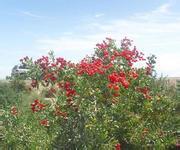Medicinal value and planting techniques of Lycium barbarum

Chinese wolfberry is an important economic plant and a good product for both medicine and food. There are 7 species of Lycium barbarum, Lycium barbarum and Lycium barbarum. Among them, there are three kinds of traditional medicinal value, namely, Huangguo Lycium barbarum (Ningxia Lycium barbarum var.), northern Lycium barbarum (Lycium barbarum var.) and Lycium barbarum L. (* Lycium barbarum var.). The tender leaves of Chinese wolfberry can be used as vegetables; the fruit is sweet and edible and can be processed into health drinks and food. Fruit, leaf, root and bark are all available for medicinal use. Chinese wolfberry fruit has the effect of nourishing kidney, regulating lung, tonifying liver and eyesight, mainly treating yin deficiency of liver and kidney, sore waist and knees, dizziness, dizziness, fatigue cough and spermatorrhea. Lycium barbarum leaves have the effects of tonifying deficiency and essence, clearing heat, relieving thirst, dispelling wind and eyesight, mainly treating fatigue and fever, irritation and thirst, eye pain, heat sore and swelling. Chinese wolfberry root bark (ground bone bark) has the effects of clearing heat, reducing fever, cooling blood and lowering blood pressure. it is mainly for the treatment of deficiency, fatigue, hot sweats, lung heat, cough and asthma, cold blood, hypertension and acne. Second, the method of reproduction. Direct broadcast afforestation. Strip sowing or hole sowing, sowing after soil thawing in late March to April in spring. The sowing depth is 1cm to 3cm. Lycium barbarum is easy to be eaten and uprooted by livestock at the seedling stage and must be banned from grazing. two。 Raise seedlings and transplant. It is best to raise seedlings in spring and autumn. 3. Cuttings and striping. The root sprouting power of Chinese wolfberry is very strong. After soaking the branches of Chinese wolfberry growing on the barren slope for 2 days, the cuttings with a diameter of 0.5 cm and a length of 30 cm can be cut. 4. Tillers reproduce. Cut off the trunk above the main rhizome of the 2-year-old Chinese wolfberry, and many young branches can sprout in the second year. The main root of Lycium barbarum can also be truncated and propagated through many young branches germinating at both ends of the truncated main root. Spring is the best time to cut off roots. Third, cultivation and management 1. Cultivation density. The plant spacing is 1.5m in barren soil and 2m in fertile land. two。 Soil and water and fertilizer management. At the initial fruiting stage, 2 ~ 5 years after planting, the main root of Lycium barbarum was truncated, which was beneficial to the germination of new branches. Chinese wolfberry should be fertilized twice a year, and the fertilization time should be from defoliation to pre-germination, topdressing during flowering and fruit setting, and irrigation after fertilization. 3. Plastic surgery, pruning. Lycium barbarum entered the full fruit period from the fifth year. All the branches were cut short in the same year, and 4-5 well-developed buds were left on each branch, and the lateral branches and extended branches were thinned and cut in the second and third year, so that the branches developed sturdy, uniform density, good ventilation and light transmission. Pruning principle: ① cultivated and maintained 15-20 backbone branches, maintained good light conditions, and cut off overdense branches. ② cut off the full length of the basal branch and cultured it into the backbone branch, and cut off the tip 3 buds and 5 buds according to the growth strength of the elongated branch and the new shoot. In order to cultivate long-lived and strong backbone branches, ③ must control the basal branches, so the basal buds should be erased during pruning, leaving only the buds intended for renewal. ④ should remove the branches with insect pests, injuries or too weak as soon as possible, and leave new branches to replenish them. Fourth, the main diseases of Lycium barbarum and its control. Black fruit disease. The fruit blackened due to anthracnose. Spray with 1000 times of methamphetamine or Dysen zinc, or control with Bordeaux solution. two。 Gummy disease. Mechanical damage causes branches to rot and flow mucus. Apply 1 ∶ 1 ∶ 15 Bordeaux solution to the glue flow. 3. Gall mites. It harms young shoots, leaves, flowers and fruits, causes galls on them, and affects growth and development. When the new leaves opened in early spring, they were sprayed with dicofol 500 times 800 times or 80% dichlorvos 1000 times 1500 times or 25% chlordimeform 500 times. 4. Fruit borer. Harm to fruits, buds and shoots, so that the injured buds can not blossom and bear fruit. The larvae were sprayed with 40% dimethoate or 80% dichlorvos 1000-1500 times, or trichlorfon 800-1000 times, or chlordimeform 300 times. Fifth, harvest and processing 1. Harvest and processing of Chinese wolfberry fruit. The harvest of Chinese wolfberry is between Grain in Beard and the Autumn Equinox. Pick ripe fruit, dry or dry in the shade. Be careful not to rub it with your hands so as not to affect the quality. When the skin is dry and the pulp is soft, it can be dried by fire when it is rainy. two。 The planing of the skin of the earth. When the Beginning of Spring is unfrozen, the quality is good and easy to peel, but the quality of the bone skin is poor after the Qingming Festival. Peel off the root bark and dry it or cut it up while it is fresh.
- Prev

Soil preparation and fertilization of medlar
Lycium barbarum is a deciduous shrub of Solanaceae, also known as wolfberry fruit, dog milk root, etc. It is a famous fruit plant. Lycium barbarum flower in June to September, fruit in September to October, its leaves, roots, fruits can be used as medicine, potted old roots can also be made into exposed roots bonsai. Lycium barbarum L. has a wide range of adaptability, lax requirements for soil, drought resistance, barren,...
- Next

The adaptability of Lycium barbarum L. is easy to plant
Lycium barbarum has strong germination power, and many new branches are issued from April to August every year, and tillers grow from the roots. Lycium barbarum is cold-resistant, light-loving and saline-alkali tolerant. There are two kinds of reproduction: sexual reproduction and asexual reproduction. Sexual reproduction will be the fruit soaked in water for 1-2 days, softened after washing out the seeds dried. Sowing in late March, covering soil 1 cm...
Related
- Fuxing push coffee new agricultural production and marketing class: lack of small-scale processing plants
- Jujube rice field leisure farm deep ploughing Yilan for five years to create a space for organic food and play
- Nongyu Farm-A trial of organic papaya for brave women with advanced technology
- Four points for attention in the prevention and control of diseases and insect pests of edible fungi
- How to add nutrient solution to Edible Fungi
- Is there any good way to control edible fungus mites?
- Open Inoculation Technology of Edible Fungi
- Is there any clever way to use fertilizer for edible fungus in winter?
- What agents are used to kill the pathogens of edible fungi in the mushroom shed?
- Rapid drying of Edible Fungi

